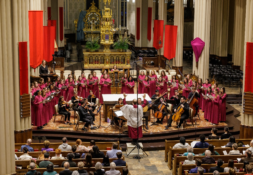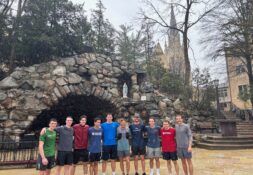“We offer you no salary; no recompense; no holidays; no pensions, but much hard work; a poor dwelling; few consolations; many disappointments; frequent sickness; a violent or lonely death.”
So ran an advertisement for the Sisters of the Blessed Virgin Mary in Aberdeen, South Dakota, penned by Mother M. John Hughes in the late nineteenth century. It captures the generous and courageous self-sacrifice that characterized the women who answered God’s call to become religious sisters in the new United States.
“Women and Spirit: Catholic Sisters in America” is an historical exhibit chronicling the often untold story of the important role that professed religious women have played since the country’s earliest history. This impressive and engaging exhibit, sponsored in part by St. Mary’s College and Notre Dame, is running at the Center for History, in downtown South Bend, until December 31. Admission is free for ND/SMC/HCC students, and $8 for adults, $6.50 for seniors, and $5 for youth.
Filled with captivating images and interesting artifacts, the exhibit presents the story of these women’s service in nursing, the care of orphans, education, and heroic assistance in war and natural disasters. These sisters fulfilled the promise made by one mother superior, quoted at the beginning of the exhibit, “Give me 12 women, and we can change the world.”
A hand-written letter from President Thomas Jefferson to Sister Therese de St. Xavier Farjon, OSU, is one of the many historical gems displayed. Writing in 1804, this superior of the Ursulines of New Orleans had expressed her concern to the president that the recent extension of American authority over Louisiana might threaten their property rights.
Jefferson assured Sister Therese and her sisters that “the principles of the constitution and the government of the United States,” guaranteed them the right to govern their affairs “according to it’s own voluntary rules, without interference from the civil authority.” The violent anti-clericalism of the French Revolution would have been a recent memory for these French nuns, making Jefferson’s response even more striking.
The president praised the work of the “holy sisters” for “its furtherance of the wholesome purposes of society, by training up it’s (sic) younger members in the way they should go, [which] cannot fail to ensure it the patronage of the government it is under.”
That the story of Catholic sisters and their important role in the larger American story is being told so compellingly is reason for celebration. However, one curious characteristic of the exhibit was the lack of any reference to God. When the sisters themselves speak directly through quotations and the other primary sources, they clearly point to him. However, he is absent from the overarching historical narrative presented by the exhibit’s authors. Surely, it was love of Christ that motivated many of these women to forsake the riches of home, marriage, and family life.
The title of the exhibit itself is also striking. “Women and Spirit” would seem to refer to the hard work, courage, and sheer pluck that American Catholic Sisters certainly exhibited throughout the generations. “Women and THE Spirit” would also have been an apt title, referring to the Holy Spirit who arguably sustained and inspired the service of these active, female religious communities.
Claire Mysliwiec is a senior history major who is not to be confused with her friend and fellow history major Claire Gillen. Contact her at cmysliwi@nd.edu.





